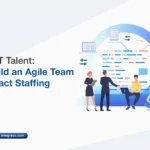Enterprise organizations rely heavily on data. However, many have data silos that are fragmented, uneven, and distributed throughout the organization. Data integration should be a priority for businesses to make sure they get the maximum value from this critical resource. Modern enterprise integration processes reduce the stress and strain of consolidating data silos; however, there are a few potential pitfalls that organizations should avoid.
Challenges in Enterprise Integration
Challenge 1: Scalability
Large organizations have huge quantities of data and problems arise with growing business needs. With growing needs, the processing time and requirements are high so the IT team struggles to implement a scalable and robust support system. Hence enterprise integration becomes a bottleneck affecting the overall performance.
Solution:
Features like pre-built integration processes and reusable components reduce or even eliminate the need for manual coding.Hence implementing an enterprise integration system would be a safe bet by implementing reusable components.
Challenge 2: Tightly coupled tools/products
Tightly coupled tools consist of parallel processes that are dependent on each other. Many of these are built for a singular purpose and can’t be reused. Migration can be challenging under these circumstances.
Solution:
When integrating with a loosely coupled toolset, it is easier for systems to work independently as part of a larger group of systems, or in close contact with multiple segmented groups of systems. The biggest benefit of loose coupling is that resources are independent and decoupled from the interface which allows for greater amounts of interoperability through extensible APIs.
Challenge 3: Selection of technology
In terms of enterprise integration, ensuring the right technology to be applied can have a tremendous impact on existing business processes. The selected technology must also seamlessly integrate the enterprise applications.
Solutions
Enterprises must view the introduction of new technologies as part of a unified, omnichannel strategy to reap the most out of their investments and their data. As a simple example, the invoicing system for the company must be compatible with the accounting tool, the accounting tool must work with the CRM, and the CRM must also work with the marketing tools, and so on.
Conclusion
Enterprise integration comes with an array of challenges that could significantly slow down business processes as opposed to speeding them up. Each challenge must be identified ahead of time and addressed proactively.









